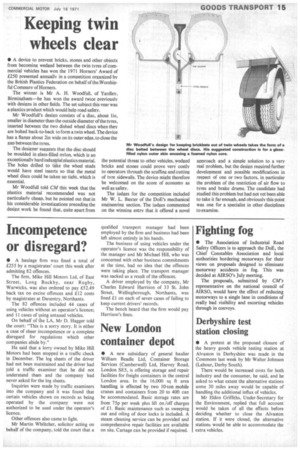Keeping twin wheels clear
Page 17

If you've noticed an error in this article please click here to report it so we can fix it.
• A device to prevent bricks, stones and other objects from becoming wedged between the twin tyres of commercial vehicles has won the 1971 Homers' Award of £250 presented annually in a competition organized by the British Plastics Federation on behalf of the Worshipful Company of Homers.
The winner. is Mr A. H. Woodfull, of Yardley, Birmingham—he has won the award twice previously with designs in other fields. The set subject this year was a plastics product which would help road safety.
Mr Woodfull's design consists of a disc, about lin, smaller in diameter than the outside diameter of the tyres, inserted between the two dished wheel discs when they are bolted back-to-back to form a twin wheel. The device has a flange about 2in wide on its outer edge, to close the gap between the tyres.
The designer suggests that the disc should be moulded in glass-filled nylon, which is an exceptionally hard industrial Plastics material. The holes drilled to take the wheel studs would have steel inserts so that the metal wheel discs could be taken up tight, which is essential.
Mr Woodfull told CM this week that the plastics material recommended was not particularly cheap, but he pointed out that in his considerable investigations preceding the design work he found that, quite apart from
the potential threat to other vehicles, wedged bricks and stones could prove very costly to operators through the scuffing and cutting of tyre sidewalls. The device might therefore be welcomed on the score of economy as well as safety.
The judges for the competition included Mr W. L. Baxter of the DoE's mechanical engineering section. The judges commented on the winning entry that it offered a novel approach and a simple solution to a very real problem, but the design required further development and possible modifications in respect of one or two factors, in particular the problem of the restriction of air flow to tyres and brake drums. The candidate had studied this problem but had not vet been able to take it far enough, and obviously this point was one for a specialist in other disciplines to examine.




























































































